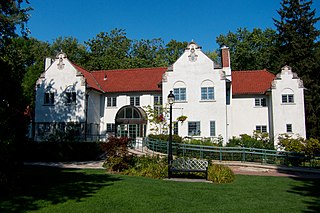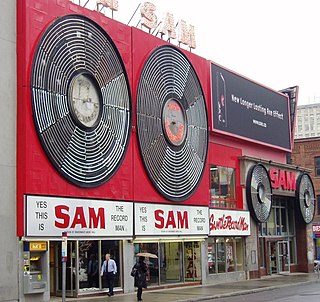
Yonge–Dundas Square, or Dundas Square, is a public square at the southeast corner of the intersection of Yonge Street and Dundas Street East in Downtown Toronto, Ontario, Canada. Designed by Brown and Storey Architects, the square was conceived in 1997 as part of revitalizing the intersection. Since its completion in 2002, the square has hosted many public events, performances and art displays, establishing itself as a prominent landmark in Toronto and one of the city's prime tourist attractions. Central to the Downtown Yonge entertainment and shopping district, the square is owned by the city and is the first public square in Canada to be maintained through a public-private partnership. The intersection is one of the busiest in Canada, with over 100,000 people crossing the city's first pedestrian scramble daily.

33 Dundas Street East is a studio complex located in Downtown Toronto, Ontario, Canada. The building was acquired by Rogers Media in 2007 as the new home of its four Toronto television stations: CITY-DT (Citytv), CFMT-DT (OMNI.1), CJMT-DT (OMNI.2) and formerly CityNews Channel. CITY-DT moved into the building on September 8, 2009, followed by the Omni stations a month later on October 19. First built in 2004, the building was home to Olympic Spirit Toronto, an Olympic-themed entertainment attraction, until 2006 and before that a three storey Salvation Army building.

PATH is a network of underground pedestrian tunnels, elevated walkways, and at-grade walkways connecting the office towers of Downtown Toronto, Ontario, Canada. It is more than 30 kilometres (19 mi) long. According to Guinness World Records, PATH is the largest underground shopping complex in the world with 371,600 square metres (4,000,000 sq ft) of retail space.

The Cawthra family of Toronto was famous for its business, social and cultural contributions to the city. It is one of the oldest families in Toronto, and many descendants of the family's founder, Joseph Cawthra, continue to play significant roles in Toronto society.

Dundas Street, is a major historic arterial road in Ontario, Canada. The road connects the city of Toronto with its western suburbs and several cities in southwestern Ontario. Three provincial highways—2, 5, and 99—followed long sections of its course, although these highway segments have since been downloaded to the municipalities they passed through. Originally intended as a military route to connect the shipping port of York to the envisioned future capital of London, Ontario, the street today connects Toronto landmarks such as Yonge-Dundas Square and the city's principal Chinatown to rural villages and the regional centres of Hamilton and London.
Anthony (Tony) Patrick Cawthra Adamson, was a Canadian architect, author, teacher, and municipal politician. He was descended from Joseph Cawthra through his mother.

College Park is a shopping mall, residential and office complex on the southwest corner of Yonge Street and College Street in Toronto, Ontario, Canada. An Art Deco landmark, the building was built between 1928 and 1930 by the Eaton's department store, and was designed by Ross and Macdonald, the Montreal architectural firm that also designed the Royal York Hotel and Maple Leaf Gardens in Toronto, the Château Laurier Hotel in Ottawa, and the Montreal Eaton's store.

Trader's Bank Building is a 15-storey, 55.39 m (181.7 ft) early skyscraper, completed in 1906 at 67 Yonge Street in Toronto, Ontario, Canada. The building was designed by Carrère and Hastings, with construction beginning in 1905. It was the tallest building in the British Commonwealth until the Royal Liver Building was completed in 1911. It remains one of Canada's few surviving skyscrapers of the early 20th Century.

The Carlu is an historic event space in Toronto, Ontario, Canada. Opened in 1930 and known as the eponymous "Eaton's Seventh Floor", the venue was restored and reopened in 2003, renamed for its original architect. The Carlu is one of Toronto's best examples of Art Moderne architecture. The venue is owned by restaurant firm Oliver & Bonacini.

Atrium is a large 1,000,000 square feet (93,000 m2) retail and office complex in Toronto, Ontario, Canada. Atrium is located adjacent to the highly popular Yonge-Dundas Square, and was built upon the former site of the former Ford Hotel Toronto, on the north side of Dundas Street West, extending from Yonge Street to Bay Street. The mixed-use building was constructed in 1981 with parking on the second and third underground levels and retail space street and concourse levels topped by an eight-storey office block that rises to 14 floors on the east end of the site and 13 on the west. As part of downtown Toronto's PATH network, Atrium's Concourse Level is directly connected underground to the Dundas subway station, the Toronto Eaton Centre south, across on Dundas Street, and the Toronto Coach Terminal located west, across Bay Street.

The Adamson Estate, which forms the eastern boundary of the Port Credit neighbourhood of Mississauga, Ontario, was purchased from the family of Agar Adamson by Credit Valley Conservation Authority in 1975 upon the urging of the local ratepayers group known as Project H21 after a proposed real estate development which would have changed the character of the neighbourhood. It is now a public park on the Waterfront Trail. It was recognized as a Historic Place in 1978.

Downtown Toronto is the city centre and main central business district of Toronto, Ontario, Canada. Located entirely within the district of Old Toronto, it is approximately 14 square kilometers in area, bounded by Bloor Street to the north, Lake Ontario to the south, the Don Valley to the east, and Bathurst Street to the west. It is also the governmental centre of the City of Toronto and the Province of Ontario.

Downtown Yonge is a retail and entertainment district centred on Yonge Street in Downtown Toronto, Ontario, Canada. The Downtown Yonge district is bounded by Richmond Street to the south; Grosvenor and Alexander Streets to the north; Bay Street to the west; and portions of Church Street, Victoria Street, and Bond Street to the east. All property owners and commercial tenants within these boundaries are members of the Downtown Yonge Business Improvement Area association, founded in 2001.
Brown and Storey Architects (B+SA) is a Canadian architecture practice based in Toronto, Ontario. Set up in 1981 by James Brown and Kim Storey –daughter of architect Joseph Storey– the office is made up of multi-disciplinary professionals –urban designers, architects, landscape designers, technologists and visualization experts– producing designs and research studies in public space, urbanism, infrastructure, and recreation landscape. B+SA is well known for their design of Yonge-Dundas Square, Toronto's busiest public space.

Ryerson University is a public research university in Toronto, Ontario, Canada. Its urban campus surrounds the Yonge-Dundas Square, located at one of the busiest intersections in downtown Toronto.

Mabel Cawthra Adamson (1871–1943) was a Canadian painter and decorator, active in the Arts and Crafts movement in Toronto.

Agar Stewart Allan Masterton Adamson was a Canadian soldier who married the Toronto heiress Mabel Cawthra. He served with distinction in the Second Boer War and in World War I, and commanded the Princess Patricia's Canadian Light Infantry from 1916 to 1918. He died after an airplane crash in the Irish sea.
























